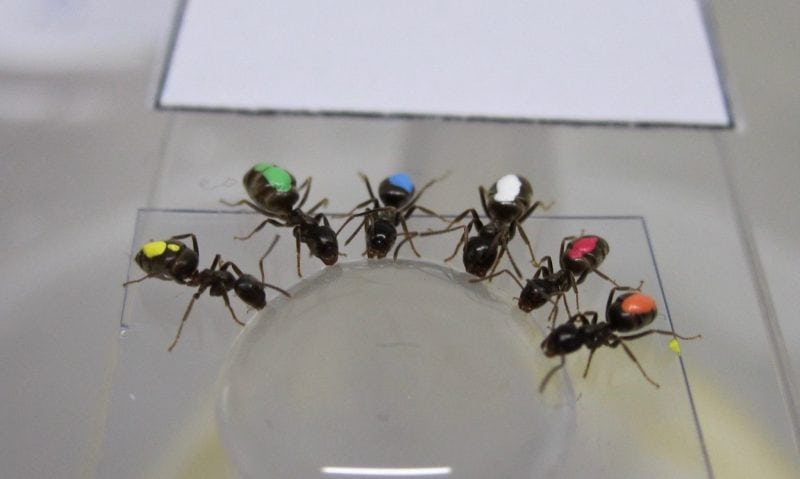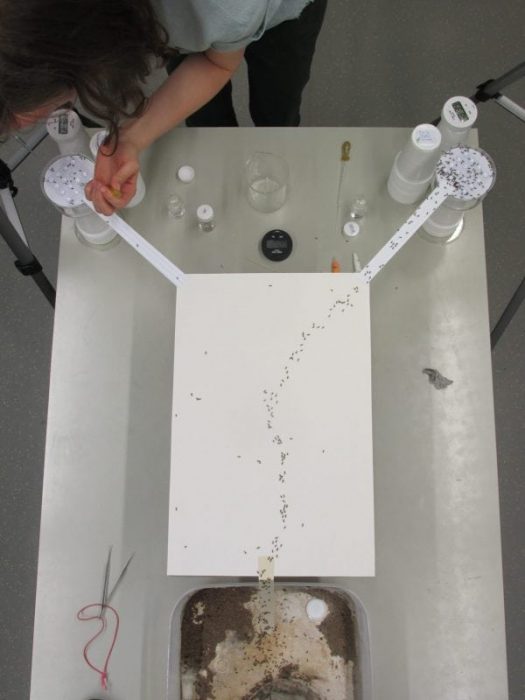
Helped along by a series of popular children’s movies, we often like to assign even the smallest animals, such as ants or fish, a full set of human-like social abilities and features. However, given the tiny brain of an ant, it seems unlikely that they could perform complex tasks, such as strategic planning.
However, an ant is never alone. They are always part of a colony, which can be composed of thousands, and even millions, of other ants. With typical foresight, in the 19th century, Charles Darwin suggested that the colony itself should be considered as a single organism – what we now term a superorganism. Thus, when investigating the complexity of ant behavior, it should also be done at the level of the colony.
We have known for some time that ant colonies can make impressively sensible “collective” group decisions, without the benefit of a leader. For example, they can work out the shortest path to a food source or choose the best of multiple food sources to exploit. They do this by having individual ants communicate with each other. A key way in which they communicate is by laying pheromone trails. The more the ants walk on a path, the stronger the pheromone trail will be. This amplification results in one preferred path for the colony – the colony has made a collective decision. The downside of this system, based as it is on amplification, is that it can lack flexibility. Even though pheromone fades after some time, ant colonies can become “trapped” in their decision. This could be a problem if, for example, the quality of a food source changes after a decision has been made.
Carolin Hübner and Tomer Czaczkes at the University of Regensburg, Germany, wanted to know whether superorganisms – in their case ant colonies – preferred high-risk options or safe bets. Humans, for example, are known to generally be “risk-averse” — given a choice between $100 for sure, and a 50% chance of getting $200, most people go for the sure payoff. They offered colonies of the ant Lasius niger two feeding stations: one offered sugary syrup of moderate sweetness, while the other “risky” option kept switching between a very sweet syrup and a very diluted one. On average, however, both options provided the same amount of sugar. Which one would the superorganism prefer? Would their decisions highly depend on the starting quality of the fluctuating feeder, maybe because the ants get trapped in that option quickly, or can they prolong their decision process sufficiently and choose the non-risky option after evaluation?

Credit: Tomer J. Czaczkes
Surprisingly, while the ants almost always made a clear choice for one of the feeders, they showed no preference for either the safe bet or the risky option. Unexpectedly, and contrary to the classical understanding of pheromone-based collective decision-making, the choice of feeder was only very weakly influenced by the initial quality of the variable feeder. It seems that the colonies could buffer their decision process to prevent too-early collective decisions to arise. The researchers are not quite sure how the ants did this, but likely mechanisms are the memories of individual ants overruling the pheromone trails, or perhaps that different ants have different strategies for laying and following pheromone.
Another factor that could mitigate the amplification of initial differences here is negative feedback. Lasius niger workers deposit less pheromone on paths that are already marked with pheromone (Czaczkes et al., 2013a), and also reduce pheromone deposition if they repeatedly encounter other ants on the trail (Czaczkes, Grüter, & Ratnieks, 2013b). Such negative feedback systems could have prevented the initial difference from being fixed. While such systems demonstrably do not prevent collective decision making, they may set an unpredictable oscillation in motion (first one option is winning, then another) which eventually becomes fixed randomly on one of the options.
“The interesting thing about this lack of preference by the colonies is that it is perfectly rational,” says Carolin Hübner, who ran the study. “After all, the ultimate payoffs from both options were identical.”
It almost seems like the ants can, as a group, integrate the value of both options, and conclude that they are the same.
By studying how ant colonies make collective decisions, scientists hope to gain deeper insights into how complex groups can adapt to changing environments. This is of great importance to us all. As our world becomes more complex, collective decision-making strategies are already playing a critical role in organizing our lives. Routing algorithms and air traffic controllers already employ ant-inspired algorithms to solve dynamic and complex problems, and ant colonies no doubt have much more to teach us.
These findings are described in the article entitled Risk preference during collective decision making: ant colonies make risk-indifferent collective choices, recently published in the journal Animal Behaviour. This work was conducted by Carolin Hübner and Tomer Czaczkes from the University of Regensburg.









